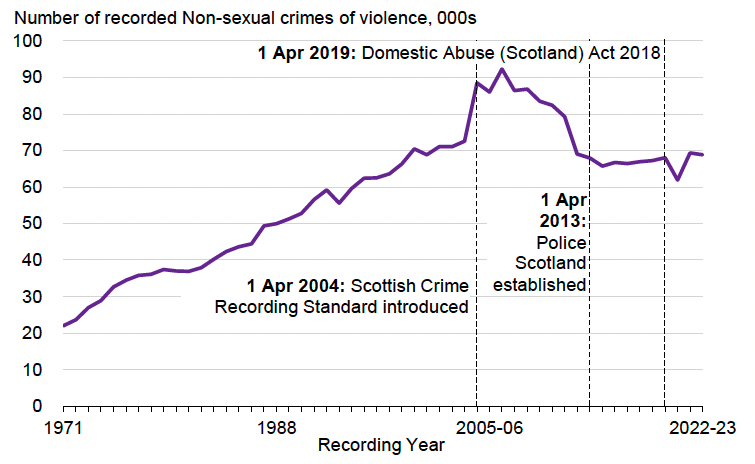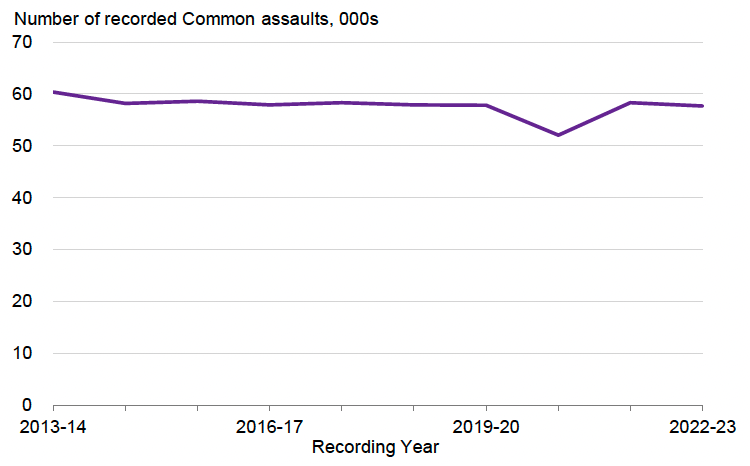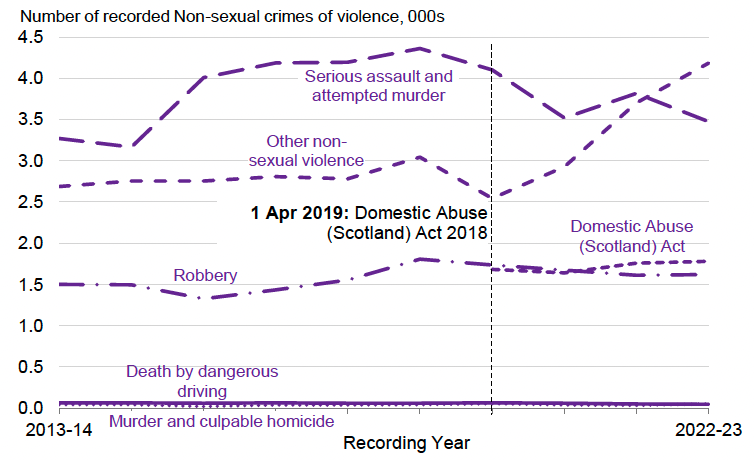Recorded Crime in Scotland, 2022-23
Statistics on crimes and offences recorded and cleared up by the police in Scotland in 2022-23, split by crime or offence group and by local authority.
This document is part of a collection
Non-sexual Crimes of Violence

Non-sexual crimes of violence accounted for almost a quarter (or 24%) of all crimes recorded in Scotland in 2022-23. Between 2021-22 and 2022-23, the number of Non-sexual crimes of violence recorded by the police in Scotland decreased by 1%, from 69,286 to 68,870.
The clear majority (84% in 2022-23) of Non-sexual crimes of violence are crimes of Common assault. Due to the size of this crime category within the group, any changes to the trend in Common assault will significantly impact the trend for the group as a whole. As such, the 1% decrease in Non-sexual crimes of violence in this latest year, is primarily due to a 1% decrease in Common assault. A 9% decrease in serious assault and attempted murder also contributed to this reduction, whilst there was a 13% increase in other non-sexual violence.
This is the fourth year of crimes being recorded within the Non-sexual crimes of violence group, under the Domestic Abuse (Scotland) Act 2018 – following its enactment on the 1April 2019. There were 1,769 such crimes recorded in 2022-23, accounting for 3% of Non-sexual crimes of violence.
Chart 4 below shows the number of Non-sexual crimes of violence from 1971 onwards. Levels of violent crime increased for a long period, before entering a downward trend following a peak in 2006-07. There has been a 25% reduction in Non-sexual crimes of violence since 2006-07. Looking at the latest ten years as a whole, the number of Non-sexual crimes of violence has remained broadly stable (increasing by only 1%), from 67,918 in 2013-14 to 68,858 in 2022-23.

Note: Data are incomplete for 1975 due to local government reorganisation.
The national rate of recorded Non-sexual crimes of violence remained unchanged at 126 crimes per 10,000 population between 2021-22 and 2022-23.
In 2022-23, of all Non-sexual crimes of violence:
- Common assault made up the vast majority, accounting for 84%
- Other non-sexual violence accounted for 6%
- Serious assault and attempted murder accounted for 5%
- Crimes under the Domestic Abuse (Scotland) Act 2018 accounted for 3%
- Robbery accounted for 2%
- Causing death by dangerous driving and Murder and culpable homicide both contributed very small proportions (both less than 0.1%) to the total
Chart 5 shows the number of Common assault crimes recorded over the latest ten years. This is presented separately from all other categories within Non-sexual crimes of violence due to the larger scale of crimes recorded in this category.
Chart 6 presents all other crime categories within Non-sexual crimes of violence over the latest ten years and gives an indication of the trend and scale of each category.


The following sections discuss in more detail the trends for each crime category within the Non-sexual crimes of violence crime group. These are:
Non-sexual crimes of violence
- Murder and culpable homicide
- Death by dangerous driving
- Serious assault and attempted murder
- Common assault
- Robbery
- Domestic Abuse (Scotland) Act 2018
- Other non sexual violence
Further details for some categories can be found in the 'Supporting documents' Excel workbook.
Murder and culpable homicide
Murder and culpable homicide accounted for a very small proportion (less than 1%) of Non-sexual crimes of violence. Crimes recorded in this category decreased by 24% over the ten year period from 2013-14 to 2022-23. This includes an 8% decrease between 2021-22 and 2022-23, from 52 to 48 recorded crimes.
Data comparisons: Homicide in Scotland National Statistics
The Scottish Government produce a separate Homicide in Scotland statistics bulletin. It contains detailed information on the crimes of Murder and Culpable homicide (common law). It presents characteristics of victims and accused, such as age and gender and the circumstances of the homicide. Users interested in Homicide statistics should use the Homicide in Scotland statistics bulletin.
The latest bulletin reports on the year of 2021-22. The data showed a decrease in the number of homicide victims compared to 2020-21, from 59 to 53. This was the lowest number since comparable records began in 1976.
Death by dangerous driving
Causing Death by dangerous driving accounted for a very small proportion (less than 1%) of Non-sexual crimes of violence. Crimes recorded in this category increased by 16% over the ten year period from 2013-14 to 2022-23. There has also been a 47% increase in the most recent year, from 34 crimes recorded in 2021-22 to 50 in 2022-23.
Serious assault and attempted murder
Serious assault and attempted murder accounted for 5% of Non-sexual crimes of violence. Crimes recorded in this category decreased by 9% between 2021-22 and 2022-23, from 3,819 to 3,476. Over the ten-year period from 2013-14 to 2022-23, this category has seen an increase of 6%, from 3,268 to 3,476.
These crimes fell between 2013-14 and 2014-15, before rising sharply in 2015-16 and then more gradually in the years that followed up to 2019-20. At least part of the increase in 2015-16 was attributed by Police Scotland to the introduction of enhanced guidance for recording Serious assault in January 2015. These crimes then fell over 2019-20 and 2020-21, before increasing in 2021-22, then decreasing again in 2022-23. The latest figure remains 20% lower than the peak in 2018-19.
For the definition of Serious assault and the distinction between Serious assault and Common assault please see Annex 1.
We previously published the findings of a more detailed study into Attempted murder & serious assault on our website.
One subset of the Serious assault and attempted murder category is the crime of Serious assault of retail worker, which came into effect on the 24 August 2021. This was introduced by the Protection of Workers (Retail and Age-restricted Goods and Services) (Scotland) Act 2021. As such, the first statistics for 2021-22 only related to a partial year. There were eight crimes recorded during this time. This has increased to 15 in 2022-23. More information on this new legislation is provided in Annex 3.
Data comparisons: Public Health Scotland Emergency Hospital Admissions as a result of Assault
Another source of statistics on assault is Public Health Scotland's annual publication on hospital admissions due to unintentional injuries. This includes the number of emergency hospital admissions for assault.
The latest published figures are for 2021-22 and are available at: Unintentional injuries - Hospital admissions year ending 31 March 2022 and deaths year ending 31 December 2021 - Unintentional injuries - Publications - Public Health Scotland.
There are several reasons why direct comparisons cannot be made between the two sources. For example, not all who attend hospital with assault injuries will report what has happened to the police, and many recorded assaults will not require inpatient hospital treatment. However, as these sources both generally relate to how Scotland's emergency services respond to the most serious types of assault, it would be anticipated that both should show similar trends over time.
In 2015 enhanced guidance was introduced which helped clarify the differences between the recording of serious assault and common assault. This very likely played a significant role in the 27% increase in police recorded serious assault and attempted murder in 2015-16 (and perhaps to a lesser extent the 4% increase in 2016-17). Looking at the years which followed, the police and hospital-based measures moved in a similar direction, with a 19% fall in emergency hospital admissions due to assault between 2016-17 and 2020-21, and a 16% decrease in police recorded serious assault and attempted murder over the same period.
In 2021-22 (the latest year for which statistics are available from both sources), there was some divergence with an increase in recorded serious assault and attempted murder, whilst hospital admissions for assault continued to fall. However recorded serious assault and attempted murder then fell again in 2022-23, and further updates will be required to determine whether the 2021-22 difference was a one-off (perhaps due to some of the factors referenced above or other pandemic-related issues) or the beginning of a longer trend. The first post-pandemic findings of the Scottish Crime and Justice Survey (due in November 2023) will also provide an additional measure on violent crime victimisation (including those cases not reported to the police), to help inform users about the latest trends in non-sexual violence in Scotland.
Common assault
Common assault is the largest category of Non-sexual crimes of violence, accounting for 84% in 2022-23. Over the ten-year period from 2013-14 to 2022-23, the number of crimes recorded in this category has fallen by 4%. There was a 1% decrease between 2021-22 and 2022-23 (from 58,306 to 57,708). This is a similar level to that before the COVID-19 pandemic (in 2019-20).
Of the 57,708 crimes recorded in 2022-23, 7,587 (13%) related to Common assault of emergency workers, a decrease of 3% since 2021-22 and an increase of 11% since 2013-14. Another subset of the Common assault category is the crime of Common assault of retail worker. 1,650 crimes (3% of all Common assault) related to Common assault of retail workers. The crime of Common assault of retail worker came into effect on the 24 August 2021, introduced by the Protection of Workers (Retail and Age-restricted Goods and Services) (Scotland) Act 2021. As such, the first statistics for 2021-22 only related to a partial year. More information on this new legislation is provided in Annex 3.
Robbery
Robbery accounted for 2% of Non-sexual crimes of violence. Over the ten year period from 2013-14 to 2022-23, this category has seen an increase of 8%. Following increases between 2016-17 and 2018-19, there were decreases for the three years between 2019-20 and 2021-22. There was a 1% increase between 2021-22 and 2022-23 (from 1,613 to 1,623).
We previously published the findings of a more detailed study into Robbery. Further information is available on our website.
Domestic Abuse (Scotland) Act 2018
Crimes recorded under the Domestic Abuse (Scotland) Act 2018 accounted for 3% of Non-sexual crimes of violence. There were 1,781 crimes recorded under the Domestic Abuse (Scotland) Act 2018 in 2022-23, the fourth year this legislation has been in place. This was a 1% increase compared to 2021-22 (from 1,760 to 1,781).
Of those crimes, 95% (or 1,689) involved a female victim and 5% (or 92) had a male victim.
It should be noted that crimes under the Domestic Abuse (Scotland) Act 2018 relate to a course of conduct only and therefore do not include all crimes relating to domestic abuse.
Annex 2 provides information on the results of HMICS Crime Audit 2020, which also examined a sample of incidents relating to domestic abuse.
Data comparisons: Official Statistics on Domestic Abuse recorded by the police in Scotland
Statistic presented in this bulletin are the primary source for users interested in the number of crimes recorded under the Domestic Abuse (Scotland) Act 2018.
However, separate analysis of domestic abuse incidents reported to the police, is presented in the Domestic abuse: statistics recorded by the police in Scotland Official Statistics bulletin. This is produced by the Scottish Government and contains details of domestic abuse incidents and crimes recorded by Police Scotland, including characteristics of victims and perpetrators, such as their age and gender.
The next Domestic abuse recorded by the police in Scotland bulletin will contain data for 2022-23 and will be published this financial year.
Other non-sexual violence
The Other non-sexual violence category includes a wide range of crime types, albeit just five accounted for 95% of the 4,184 crimes recorded in 2022-23. This included Threats & extortion (48% of all Other non-sexual violent crimes), Stalking (20%), Cruelty to & unnatural treatment of children (15%), Abduction (6%) and Drugging (6%). More detail on the crimes included is provided in the User Guide.
Crimes recorded as Other non-sexual violence accounted for 6% of Non-sexual crimes of violence in 2022-23. Over the ten year period from 2013-14 to 2022-23 this category has seen an increase of 56%, including an increase of 13% from 3,702 in 2021-22 to 4,184 in 2022-23.
These increases are primarily due to increases in crimes of Threats and extortion, which are up 44% in the latest year (from 1,398 in 2021-22 to 2,008 in 2022-23) and are more than five times higher than ten years ago (from 309 in 2013-14). Ninety-one percent of crimes of Threats and extortion were estimated to be cyber-crimes in 2022-23 (further information on this is available in the Cyber-crime chapter).
The number of drugging crimes has fallen by 42% from 444 in 2021-22 to 257 in 2022-23, however they remain substantially higher than the period from 2013-14 to 2020-21 when no more than 24 drugging crimes were recorded in any year.
Contact
Email: JusticeAnalysts@gov.scot
There is a problem
Thanks for your feedback